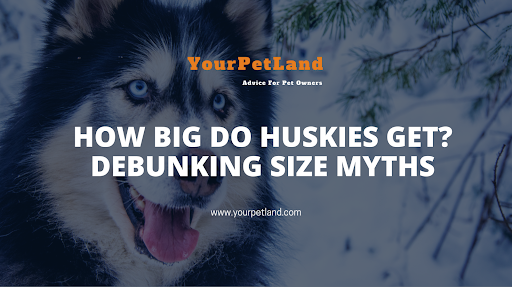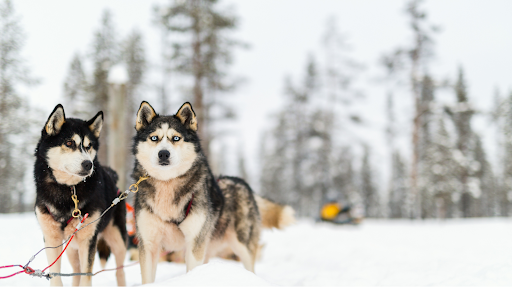How Big Do Huskies Get? Debunking Size Myths
Siberian Huskies, known for their striking appearance and amiable nature, often raise questions about their size. This article aims to dispel myths surrounding their size and provide accurate information for potential and current Husky owners. We’ll explore the typical size range, factors influencing growth, and compare them with other breeds.
Understanding the Siberian Husky Breed
The Siberian Husky, originating from Northeast Asia, was bred by the Chukchi people. Initially used for sled pulling and companionship, these dogs are admired for their endurance and resilience in harsh climates.
Breed Characteristics
Siberian Huskies are a breed that captivates with their distinct physical characteristics and temperament. They are medium-sized working dogs, exhibiting a balance of power, speed, and endurance. Notable for their thick double coat, they are well-equipped to handle cold climates. Their coat comes in various colors and patterns, and their striking eyes can be blue, brown, or even a mix of both, a feature known as heterochromia. These physical traits not only contribute to their stunning appearance but also serve practical purposes in their original environment.
In terms of temperament, Huskies are known for their friendly and outgoing nature. They are typically very sociable and enjoy the company of humans and other dogs. Despite their size, they are often described as gentle and good-natured, making them excellent family pets. However, their high energy levels and intelligence mean they require regular mental and physical stimulation. Without it, they can become bored and potentially destructive. This breed’s unique combination of traits makes them a wonderful but demanding companion, suited to active households that can meet their exercise and companionship needs.
Typical Size Ranges
Male Siberian Huskies typically stand between 21 to 24 inches at the shoulder, weighing around 45 to 60 pounds. Females are slightly smaller, usually measuring 20 to 22 inches tall and weighing between 35 to 50 pounds.
| Gender | Height Range (inches) | Weight Range (pounds) |
| Male Huskies | 21 – 24 | 45 – 60 |
| Female Huskies | 20 – 22 | 35 – 50 |
Growth Patterns
Huskies reach their full height by about 12 months but may continue to fill out and gain muscle until they are around 18 months old. Their growth can be influenced by genetics, diet, and overall health.
Factors Influencing Husky Size
Understanding the factors that influence the size of a Siberian Husky is crucial for ensuring their optimal growth and development. The primary determinant of a Husky’s size is genetics, as the traits inherited from their parents play a significant role in determining their final size. Dogs bred from larger parents are more likely to grow bigger, while those from smaller lineage tend to be on the smaller side.
In addition to genetics, nutrition and overall health significantly impact a Husky’s growth. A balanced diet rich in essential nutrients is vital during their formative months to support healthy development. Overfeeding can lead to obesity, which is a common issue in the breed, whereas underfeeding during puppyhood can result in stunted growth. Regular health check-ups are also important to ensure any potential issues that could affect growth are addressed promptly.
Nutrition and Health
Proper nutrition during the puppy stage is crucial for healthy development. Overfeeding can lead to obesity, while underfeeding can hinder growth. Regular veterinary check-ups ensure they are growing at a healthy rate.
Comparing Huskies with Other Breeds
To provide context, here’s a comparison of Huskies with similar and different-sized breeds:
| Breed | Average Height (inches) | Average Weight (pounds) |
| Siberian Husky | 20-24 | 35-60 |
| Alaskan Malamute | 23-25 | 75-85 |
| German Shepherd | 22-26 | 50-90 |
| Labrador Retriever | 21-24 | 55-80 |
| Golden Retriever | 21-24 | 55-75 |
Behavioral and Lifestyle Comparison
While similar in size to some breeds, Huskies are unique in their energy levels and exercise needs. They require more vigorous exercise compared to breeds like Golden Retrievers.
Managing Growth and Development
Effectively managing the growth and development of a Siberian Husky is key to ensuring they mature into healthy, well-adjusted adults. This involves a balanced approach to nutrition and exercise, tailored to their specific needs at each stage of growth. During their puppy phase, which is the most crucial period for their development, providing a diet rich in nutrients that promote healthy bone and muscle growth is essential. Puppy-specific formulas are recommended, as they are designed to support the rapid growth phase. Additionally, portion control and regular feeding schedules help prevent overeating and obesity, common issues in the breed.
Exercise is equally important in a Husky’s development. While they are known for their high energy and endurance, it’s important to balance their physical activity with their growth stage. Puppies, for instance, should not be over-exercised as their bones and joints are still developing. As they grow, the intensity and duration of exercise can be gradually increased. Regular physical activity not only helps in maintaining a healthy weight but also aids in muscle development and overall wellbeing. Integrating training and socialization into their exercise routine from an early age is beneficial for both their physical and mental development. This holistic approach to managing growth and development lays the foundation for a healthy, happy Husky.
Exercise and Training
Adequate exercise not only supports physical development but also aids in behavioral training, which is crucial for energetic breeds like Huskies.
Common Myths about Husky Size
One common myth is that Huskies are as large as wolves, which is not true. Huskies are medium-sized dogs and much smaller than wolves.
While most Huskies fit within the standard size range, there can be variations. It’s important not to confuse them with larger breeds like the Alaskan Malamute.
Conclusion
Huskies are a fascinating breed with a distinct size and appearance. By understanding their growth patterns and needs, owners can ensure these charismatic dogs lead a healthy and fulfilling life.
Unleash Your Husky’s Potential with YourPetLand
Discover the path to your Husky’s optimal growth and well-being with YourpetLand, your dedicated pet advisor. From tailored nutrition plans to exercise guides, YourPetLand offers expert advice and resources to help your Husky thrive. Visit us now and embrace the journey towards a healthier, happier Husky.


